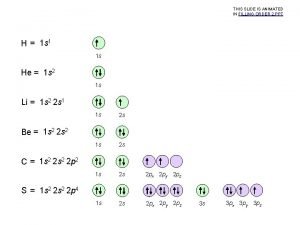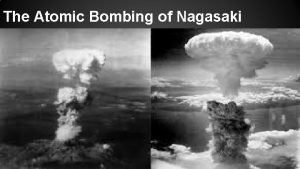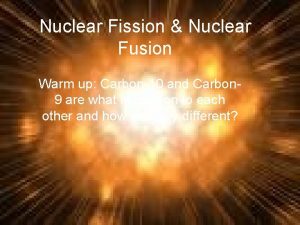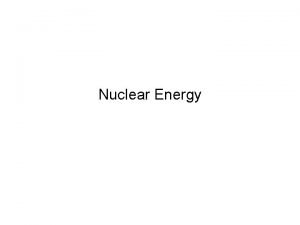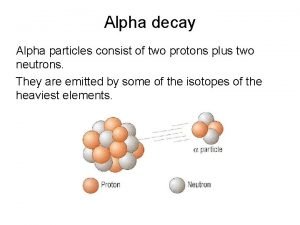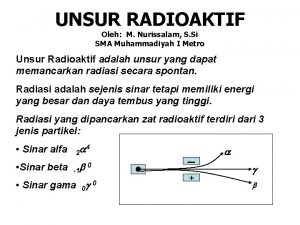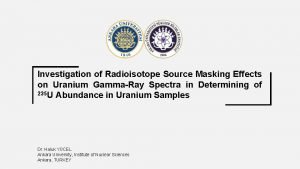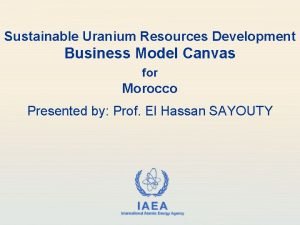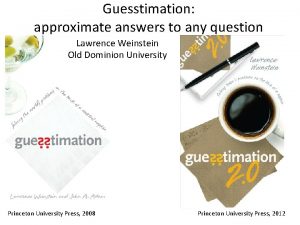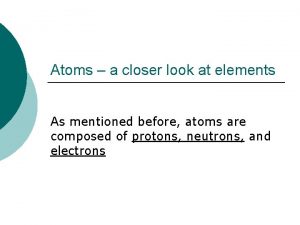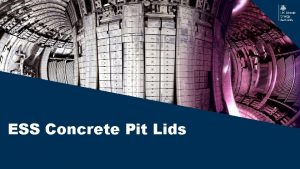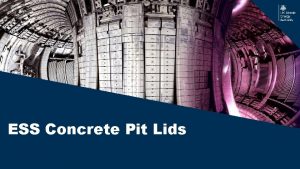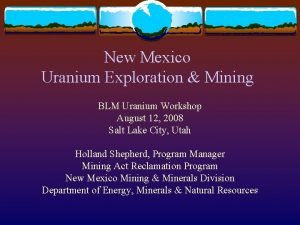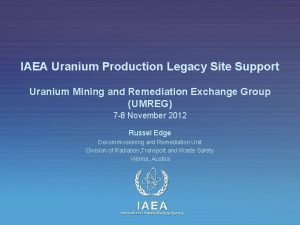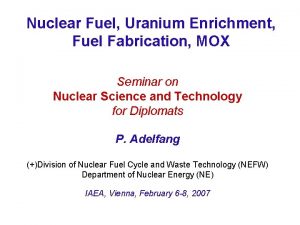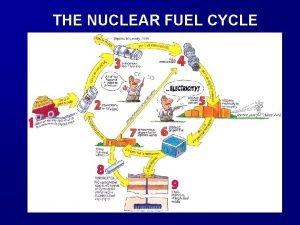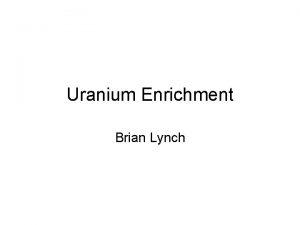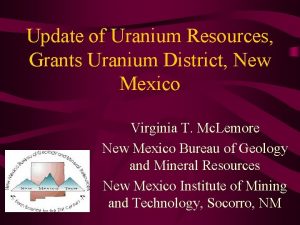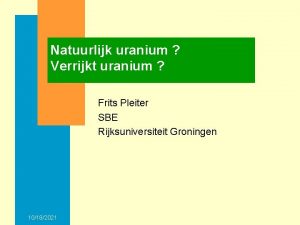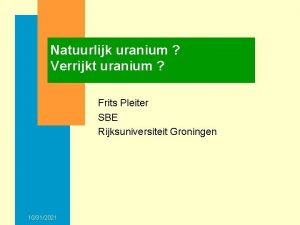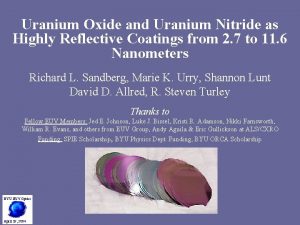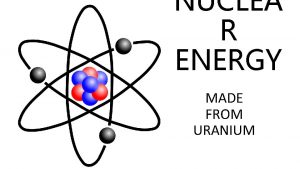Uranium Fuel Cycle 1 Conventional Mining UndergroundOpen Pit




















- Slides: 20

Uranium Fuel Cycle 1

Conventional Mining: Underground/Open Pit Ranger, Australia, Northern Territories Olympic Dam, South Australia 2

ISR: Drilling – Well Construction 3

ISR: Minimum Disturbance of Environment 4

ISR Plant – Schematic 5

ISR Plant – Beverley, South Australia 6

Ion Exchange Resins 7

Beverley Plant – Impressions IX columns Filtration units Yellowcake Sampling The product

BACKUP 9

Si. C-Si. C Composite Cladding has Potential to Significantly Improve Safety of Light Water Reactors Fukushim a Daiichi Eliminate hydrogen explosions Zr + 2 H 2 O Zr. O 2 + 2 H 2 Si. C + 4 H 2 O Si. O 2 + CO 2 + 4 H 2 For Zircaloy, destruction by steam reaction occurs at lower temp than fuel melt For Si. C/Si. C, structural failure occurs at lower temp than steam reaction At higher temps (~1400 o. C) Zircaloy reaction heat exceeds decay heat General Atomics Proprietary Data 10

Comparison of EM 2 vs Fukushima Plant To Earthquake & Tsunami 9. 0 magnitude earth quake/tsunami: reactor vessels and containments are intact but all electrical power is severed air draft heat exchanger Fukushima EM 2 Grade level Reactor Redundant shutdown cooling Turbinegenerator Leak-tight, below-grade containment • Without power, cooling systems are inoperable • Fuel heats up causing high pressure and hydrogen producing reactions from zircalloy clad • External means of cooling is needed until power to cooling systems is restored • Reactor cooling by natural convection – no power needed • Silicon-carbide clad does not react with helium coolant at high temperature • Walk-away safe – no external intervention needed General Atomics Proprietary Data

Fuel Resources for Electric Power Generation in the U. S. A. U. S. Energy Reserves (Trillion Bbls Oil Energy Equivalent) Depleted uranium (DU)/ Used nuclear fuel (UNF) inventories 8 TBbl Depleted Uranium 1 TBbl Used Nuclear Fuel 12 Energy supply for > 300 years electric power generation

“Convert & Burn” reactor achieves a 30 -year fuel life by converting 238 U to 239 Pu and burning in situ Be. O reflector Graphite reflector Starter Control drum location n versio r Starte B 4 C neutron Shield LEU: ~ 12% Lowenriched uranium DU: Depleted uranium TRU: Transuranics UNF: Used nuclear fuel MOX: Mixed U/Pu oxides NU: Natural uranium Recycled EM 2 discharge 30% 232 Th 70% 238 U Core support floor 316 L General Atomics Proprietary Data 13 Fertile

EM 2 Changes the Game Relative to Nuclear Waste LWR Waste Disposal EM 2 Waste Disposal • Deep geologic repository • Above ground storage • Million year life • 400 year life • Large storage capacity • Small storage capacity • Long term heat • Short term heat • Long term radioactivity • Short term radioactivity General Atomics Proprietary Data

BACKUP 2 General Atomics Proprietary Data 15

ISR Mining Process • • Groundwater pumped to surface (at start-up) Small amount of acid and oxidant added Water pumped back into aquifer Uranium leached Water pumped to surface Uranium recovered by ion exchange (IX) Water recycled [up to 100 recycles (pore volume exchanges)] 16

Leaching Chemistry • Uranium ore – Uranium as U(IV) fixed in minerals, e. g. pitchblende UO 2, coffinite USi. O 4 • Mobilization of uranium by oxidation and complexation – Uranium needs to be oxidized to U(VI) to form soluble uranyl ions UO 22 - • Leaching methods – Alkaline (carbonate) leaching: UO 2(CO 3)22 - and higher-order complexes – Acidic (sulfuric acid) leaching: UO 2(SO 4)22 - and higher-order complexes – Application of oxidants: O 2, H 2 O 2 17

Uranium Recovery • Mining solution contains anionic uranyl complexes like UO 2(CO 3)22 - or UO 2(SO 4)22 • Recovery from mining solution by ion-exchange (IX) – Resin (in form of beads at 0. 5 -1 mm diameter) – Resin beds in big columns (about 2 -4 m diameter, 3 -10 m height) – Mining fluid passes IX columns and recycles to wellfields – Uranium is adsorbed on the resin • Strip of uranium from IX resin by highly-ionic solution, e. g. salt solutions (Na. Cl) • Further processing includes precipitation of uranium as uranium oxide, thickening, de-watering, drying, packaging 18

ISR – Hydrogeology For ISR mining, ore body must have following properties: – Ore body must be in an aquifer (sedimentary formation) – Aquifer sediments must be permeable – Aquifer should be vertically confined (above and below) by impermeable layers 19

Beverley ISR Mine – Processing Plant 20
 Strip mining vs open pit mining
Strip mining vs open pit mining Strip mining vs open pit mining
Strip mining vs open pit mining Difference between strip mining and open pit mining
Difference between strip mining and open pit mining Text and web mining
Text and web mining Multimedia data mining
Multimedia data mining Eck
Eck 3p4
3p4 Plutonium vs uranium bomb
Plutonium vs uranium bomb Who discovered uranium
Who discovered uranium Uranium 238 decay
Uranium 238 decay Orbital diagram for na
Orbital diagram for na U-238 decay equation
U-238 decay equation Uses of uranium
Uses of uranium Inti atom uranium 235u92 terdiri atas
Inti atom uranium 235u92 terdiri atas Masking uranium
Masking uranium Is uranium a main group element
Is uranium a main group element Uranium phosphate maroc
Uranium phosphate maroc Uranium ore
Uranium ore Uranium atomic mass
Uranium atomic mass Xkcd uranium energy density
Xkcd uranium energy density Whats the atomic mass of uranium
Whats the atomic mass of uranium






